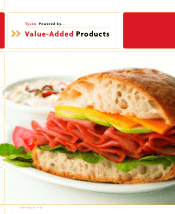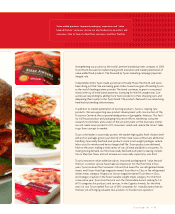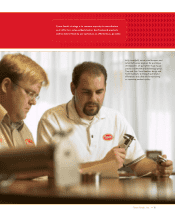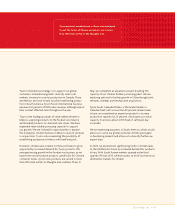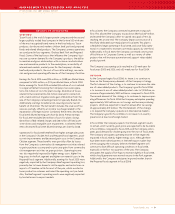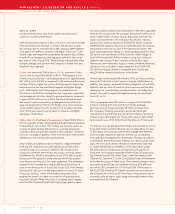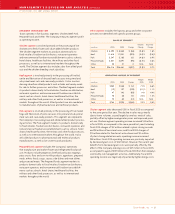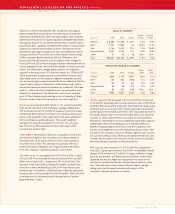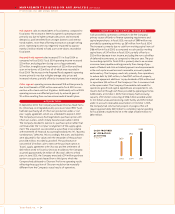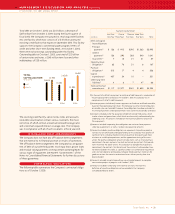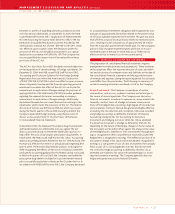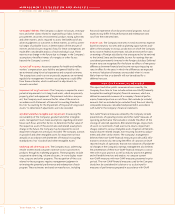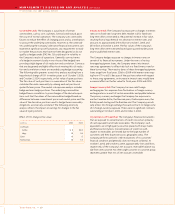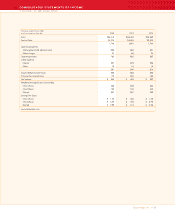Tyson Foods 2005 Annual Report Download - page 24
Download and view the complete annual report
Please find page 24 of the 2005 Tyson Foods annual report below. You can navigate through the pages in the report by either clicking on the pages listed below, or by using the keyword search tool below to find specific information within the annual report.
>> MANAGEMENT’S DISCUSSION AND ANALYSIS (CONTINUED)
TYSON FOODS, INC. 2005 ANNUAL REPORT
Tyson Foods, Inc. >> 22
Beef segment sales decreased 2.8% in fiscal 2005 as compared to
the same period last year. The decline in sales primarily resulted
from the effects of import and export restrictions. Those restric-
tions contributed to lower international sales volumes and lower
average domestic sales prices due in part to the mix of products
allowed for export. Additionally, the current year had one less
week of sales. Fiscal 2005 operating income decreased $215 million
as compared to the prior year, excluding $10 million received in
connection with vitamin antitrust litigation in fiscal 2005, prior
year BSE-related charges of $61 million and $5 million of charges
related to intangible asset impairments and fixed asset write-
downs recorded in fiscal 2004. The decrease in operating income
was primarily due to lower domestic cattle supplies and restric-
tions on imports of Canadian cattle for most of the year, which
resulted in lower production volumes and raised the operating
cost per head. Additionally, operating income was negatively
impacted by decreased volumes and margins at the Company’s
Lakeside operation in Canada.
Pork segment sales increased 1.9% in fiscal 2005 as compared to the
same period last year. The increase in sales resulted primarily from
higher average sales prices, both domestically and internationally,
as compared to the same period last year. The higher average sales
prices, driven primarily by higher average live hog prices, were partially
offset by a decrease in volumes, caused largely by one less week of
sales. Fiscal 2005 operating income decreased $63 million as compared
to the prior year, excluding current year costs of $33 million related
to a legal settlement involving the Company’s live swine operations,
$2 million received in fiscal 2005 in connection with vitamin anti-
trust litigation and $1 million of charges recorded in fiscal 2004
related to fixed asset write-downs. The decrease in operating
income was primarily due to higher average live hog prices and
lower volumes, which increased the operating cost per head and
more than offset the increase in average sales prices.
Prepared Foods segment sales decreased 3.1% in fiscal 2005 as
compared to the same period last year. The decline in sales was
primarily due to lower volumes, caused largely by one less week of
sales and the rationalization of lower margin product lines, partially
offset by higher average sales prices. Fiscal 2005 operating income
decreased $2 million as compared to the prior year, excluding plant
closing related accruals of $2 million and $27 million recorded in
fiscal years 2005 and 2004, respectively, and excluding $27 million
of fixed asset write-downs and intangible asset impairments
recorded in fiscal 2004. The decrease in the Prepared Foods
segment’s operating income was primarily due to increased
raw material prices.
2004 VS. 2003
Certain reclassifications have been made to prior periods to
conform to current presentations.
Sales increased $1.9 billion or 7.7%, with a 9.4% increase in average
sales price and a 1.5% decrease in volume. The increase in sales
primarily was due to higher average selling prices. Volumes declined
due to a reduction in international export activity related to the
Chicken and Beef segments resulting from import restrictions
imposed by various countries. Additionally, the Company’s Beef
segment domestic volumes decreased due to tightened supply of
live cattle, the effects of higher beef pricing and significant
competing protein supplies in the marketplace.
Cost of sales increased $1.7 billion or 7.7%. As a percent of sales,
cost of sales decreased from 92.9% to 92.8%. The increase in cost
of sales primarily was due to increases in grain costs in the Chicken
segment, which were partially offset by gains resulting from the
Company’s commodity risk management activities related to grain
purchases, and in the Beef segment, higher live cattle prices and
BSE-related charges. Also included in fiscal 2004 cost of sales was
$18 million to reduce self-insurance reserves to the actuarially
determined range. The reserves are compared to actuarial estimates
quarterly. Fiscal 2003 had a $6 million reduction in self-insurance
reserves. Additionally, fiscal 2003 cost of sales included $167 million
received in connection with vitamin antitrust litigation.
Selling, general and administrative expenses increased $49 million
or 5.9%. As a percent of sales, selling, general and administrative
expenses decreased from 3.4% to 3.3%. The increase in expenses
primarily was due to an increase in personnel and incentive-based
compensation of approximately $40 million, an increase of approxi-
mately $20 million related to information system technology
improvements, an increase of approximately $21 million in
employee benefit costs, primarily due to fiscal 2003 actuarial gains
of $13 million related to certain retiree medical benefit plans and
fiscal 2004 increases in healthcare-related costs. The increases were
partially offset by a reduction in auditing, legal and professional fees
of approximately $27 million, which included $12 million received
in fiscal 2004 related to legal settlements from the Company’s
insurance providers.
Other charges included plant closing costs of $40 million and
$76 million recorded in fiscal years 2004 and 2003, respectively.
Fiscal 2004 costs primarily were related to the closings of the
Company’s Jackson, Mississippi, Manchester, New Hampshire,
Augusta, Maine, and Berlin, Maryland, facilities. As part of its
on-going plant rationalization efforts, the Company announced
in February 2004 its decision to consolidate its manufacturing
operations in Jackson, Mississippi, into the Company’s Carthage,
Mississippi, facility. The Company acquired the Carthage facility
when it purchased Choctaw Maid Farms in the fourth quarter
of fiscal 2003. In December 2003, the Company announced its


